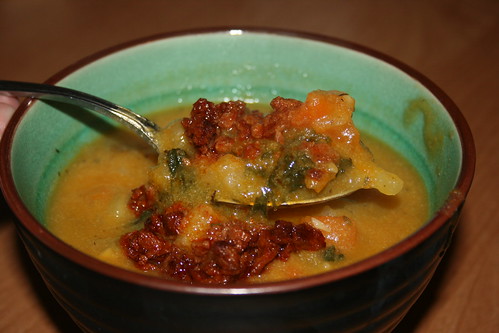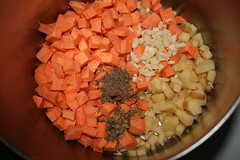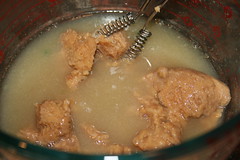Also, when I made this soup I completely forgot to put the onions in at the beginning, and ended up sauteeing them separately later. Since it came out so great, I'm going to pretend that's what made all the difference, and that mistake has been preserved in the directions below. But I'm sure you could just throw the onions in with the rest of the veggies and pour in a couple of Tablespoons of olive oil ...

Peel a
large yam (about 19 ounces)
and cut it into small bite-size pieces along with a
small Yukon gold potato (about 8 ounces)
Throw the yam and potato chunks into a large pot, along with
6 cloves of coarsely chopped garlic
1 tsp. dried thyme
1 tsp. dried oregano
4 cups vegetable broth
2 cups water
and bring to a boil over high heat, covered. Once boiling, reduce the heat to low and simmer for about 30 minutes, until the yams and potatoes are very soft.

Remove
2 cups of the cooked vegetables in cooking liquid
from the pot and puree in a blender or food processor along with
5 ounces okara
Once pureed, return to the soup pot. If desired, you can mash the remaining yams and potatoes with a potato masher or other mashing implement.
Saute
a medium-sized white onion, finely chopped
in
2 Tablespoons olive oil
for 5 to 10 minutes, until onions are translucent but not browned. Add them to the soup pot along with
5 ounces kale (stems removed and chopped into small pieces)
1 Tablespoon white wine
and increase the heat to medium. Stir until the kale is wilted.
NB: This should have only taken maybe 5 minutes, but because I used prepackaged kale from Trader Joe's, I had to cook this for about 15 minutes. Why? Because the TJ's kale didn't have the thick stems removed, so it had to be cooked for a lot longer! In the end this wasn't a problem, so if you don't want to remove the stems I guess you don't have to -- just be prepared to cook it longer, until the stems are nice and soft.
When the kale is wilted, add
1 1/2 tsp. salt
ground pepper, to taste
1 tsp. white vinegar
and stir seasonings into the soup. Turn off heat and let the soup rest while you lightly saute the chorizo.
There really aren't instructions for the chorizo -- I just sauteed some store-bought vegan chorizo in some olive oil for a few minutes, being careful not to burn it. How much chorizo you garnish your soup with depends on your tolerance for heat and your own personal tastes. I probably used about a Tablespoon of chorizo per cup of soup.
Ladle soup into a bowl, garnish with desired amount of chorizo, stir chorizo into the soup, enjoy!
Verdict: This is one of my new favorite soups. I love the combination of yams, potatoes, and chorizo, and love finding ways to sneak kale into my food (not to mention okara).













